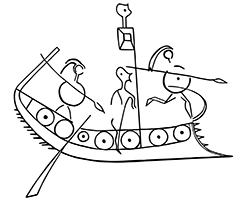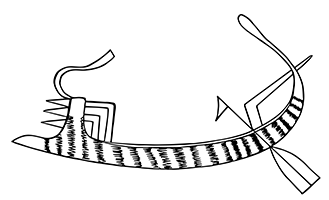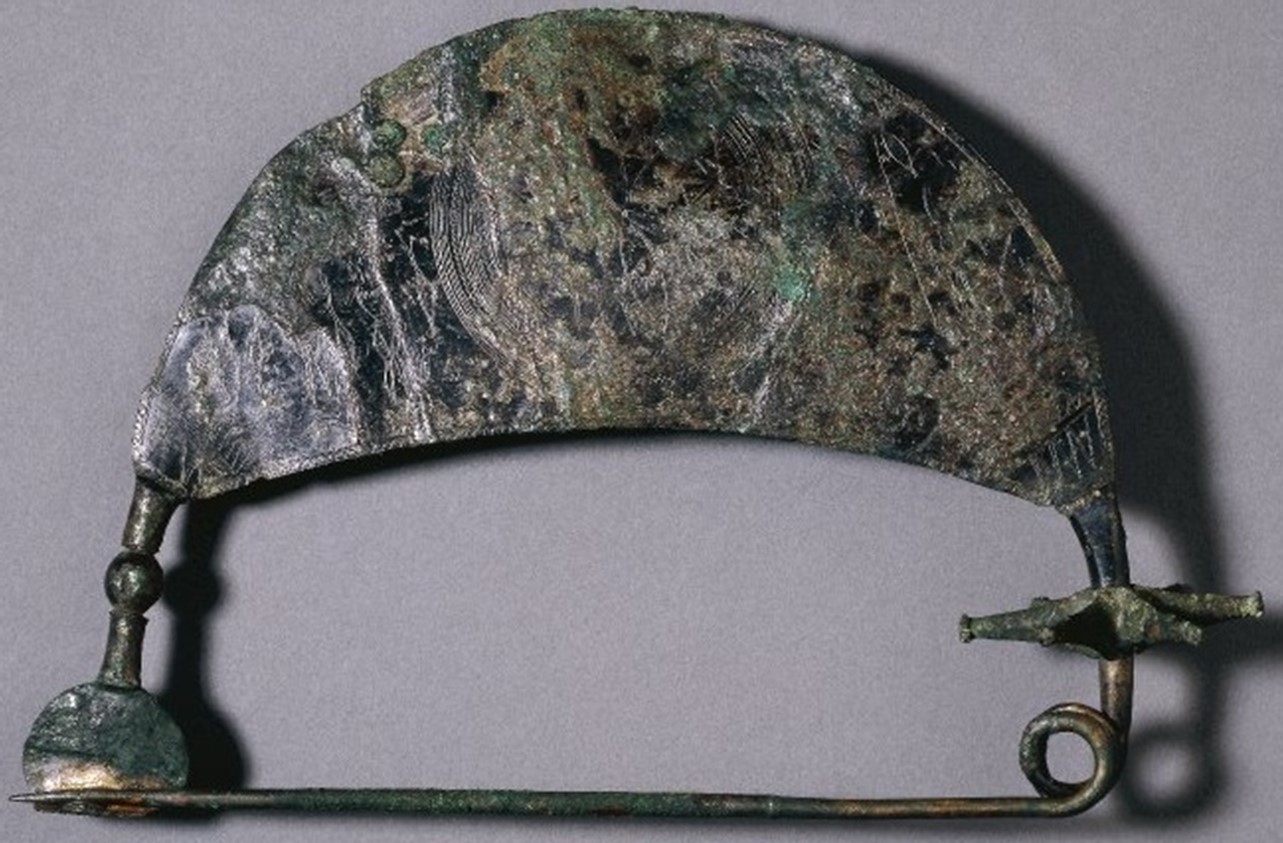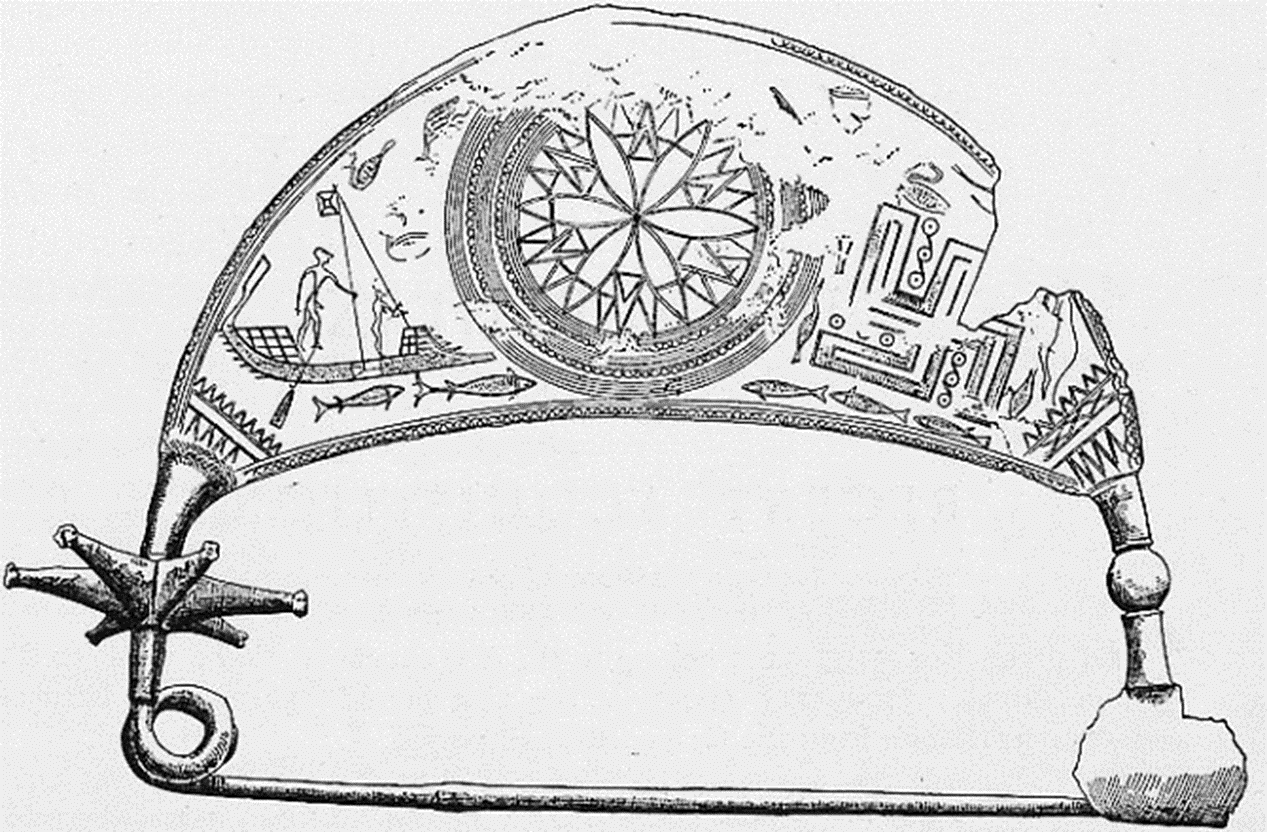Single-leveled ship to the right with a low flat hull. The bow is triangular, with a concave stempost integrating a break-shaped ram and capped by a flat horizontal extremity that lacks a decorative device. There are four short horizontal timbers tapering to a pointed tip projecting from the stermpost. The forecastle is not integrated to the bow but appears as a separate rectangular piece divided into squares that probably indicate a side of the side screen that is not solid. Basch suggests that this was in fact a piece of fabric mounted on a light wooden frame. The sternpost is high and incurving, bending sharply inwards into a paddle-shaped device at the level of the upper edge of the aftercastle. Eight short planks protrude from the sternpost similar to the bow. The aftercastle is divided into squares and thus resembles the forecastle except that it is much larger. A single quarter rudder with a paddle-shaped oar blade with a central rib is attached at the base of the aftercastle. The mast is amidships, with a forked/bisected V top (karchesion) and a single forestay. The base of the mast does not begin at the level of the gunwale as on most representations, but instead continues midway down the hull. It is furthermore encased in a rectangular box bisected horizontally by a line that forks on the left side. Since the mast begins at the base where this horizontal line forks, this is surely the notched thwart in which the mast step rests when it is set up, with the rectangular box representing the mast step. There is a crow's nest that hangs on the afterside of the masthead, rendered as a rectangle with a smaller square inside, their corners joined by four oblique lines.
Single-levelled galley
A68
Boeotia, possibly Thebes
L: 24.13 cm
Bronze fibula with the bow formed from a thin, vertical, crescent-shaped plate with incised decoration. The foot is a moulded knob terminating in a flat piece bent up to hold the pin. Above the spiral at the head are six spikes with rosettes on their tips.
British Museum 1898.0226.1
Basch 1987: 193, no. 409; Hampe 1936: no. 100; Morrison and Williams 1968: 76, Arch. 10; Walters 1899: 372-73, no. 3204, fig. 85
Side A: A large rosette occupies the center, filled with six large petals alternating with groups of three smaller ones, framed by concentric rings and intersecting arches. In the left corner is a ship facing to the right, with two nude men. The larger figure on the left is holding onto the mast with his left hand, his feet floating above the gunwale, one of them touching the side of the aftercastle, the other overlapping with the quarter rudder. The smaller figure on the right stands on a deck at gunwale level and is grasping the forestay with both hands. Below the hull are two large fishes, while two birds hover above. In the right corner is a large meander-cross, with three fishes below and four birds hovering above. At either end of the bow are chevron and lozenge patterns
Side B: a large rosette occupies the center as on side A. In the left corner are two figures, each holding up a bird by the neck in their left hand. There are three birds to their left and three fishes above. In the right corner a man is being attacked by a bowl or a lion which he is fending off with a spear. Behind the beast is a scorpion, with six birds above and a fish below. At either end of the bow are chevron and lozenge patterns.
This depiction is especially valuable for its unusually detailed depiction of the mast step system as well as the presence of a crow's nest. The castles also appears to be different in nature, possibly consisting of light screens made of fabric.
Basch, L. 1987. Le musée imaginaire de la marine antique. Athens: Institut Hellénique pour la preservation de la tradition nautique.
Hampe, R. 1936. Frühe griechische Sagenbilder in Böotien, Ate¬ne : Deutsches archäologisches institute.
Morrison, J.S. and R.T. Williams. 1968. Greek Oared Ships: 900-322 B.C. Cambridge: Cambridge University Press.
Walters, H.B. 1899. Catalogue of the Bronzes, Greek, Roman, and Etruscan, in the Department of Greek and Roman Antiquities, British Museum. London: Printed by order of the Trustees of the British Museum.








